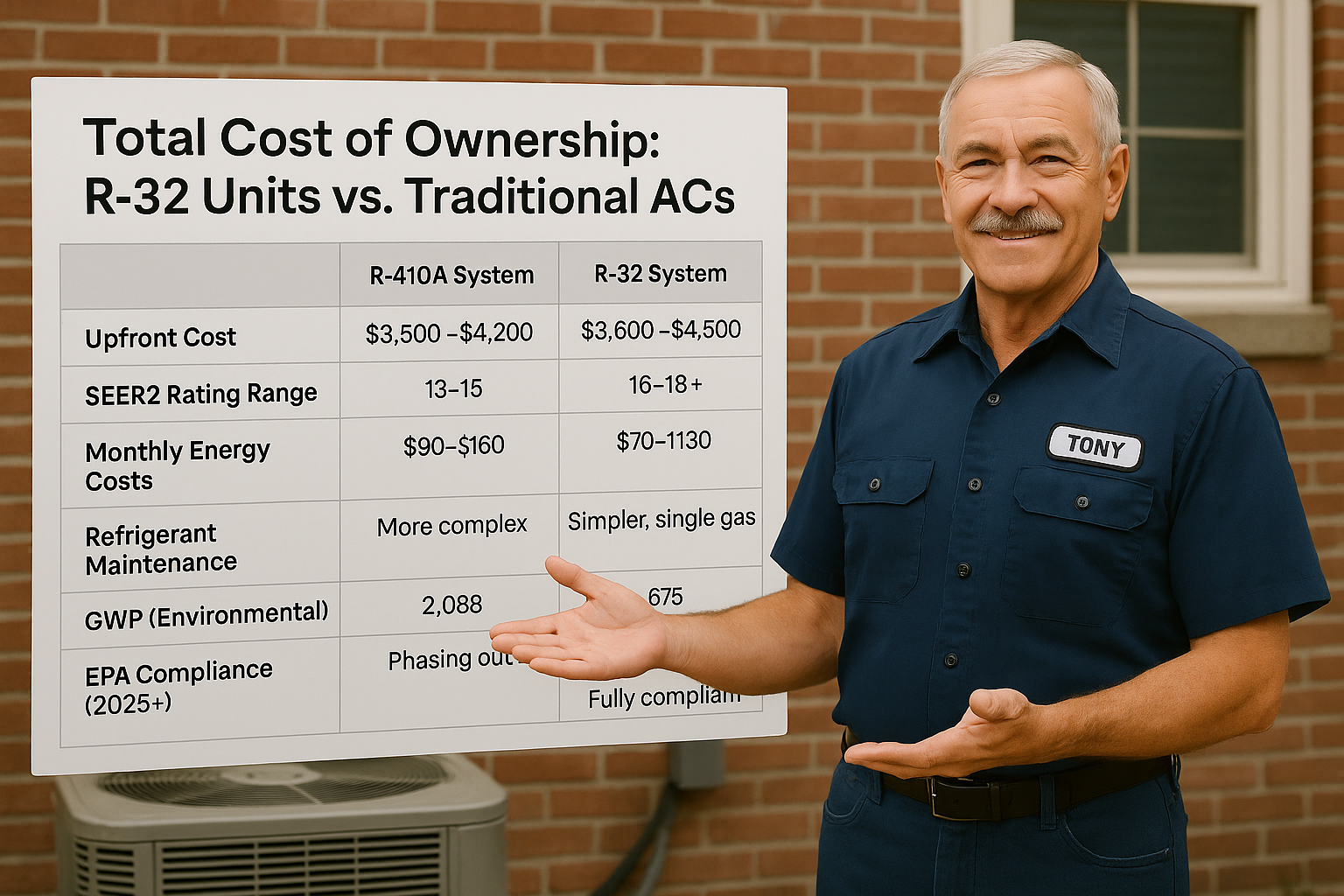Hey folks—Tony here again. When you’re shopping for a new air conditioner, price tags can be deceiving. That lower-cost unit might look like a deal, but what you really want to consider is the total cost of ownership—everything from your energy bill to maintenance and refrigerant costs over 10–15 years.
So let’s break it down: how do R-32 systems stack up against older refrigerant-based systems like R-410A?
🧾 1. Upfront Cost: Close, But Falling Fast
Historically, R-32 systems carried a small premium due to newer technology. But in 2025, the price gap is closing fast. More manufacturers are transitioning to R-32, meaning parts and units are becoming more available and affordable.
Most R-32 3-ton units now cost within $100–$300 of their R-410A counterparts, depending on brand and coil configuration.
🔗 Source – Mitsubishi Electric: Refrigerant Trends
🔗 Source – Daikin: Transition to R-32 Explained
⚡ 2. Monthly Energy Bills: 10–20% Lower
Thanks to its higher efficiency and lower refrigerant charge, an R-32 unit can reduce your monthly energy costs by $15–$40/month, especially in hot, humid areas. Over the life of the unit, that’s thousands in savings.
🔗 Source – U.S. Department of Energy: Cooling Efficiency Overview
🔗 Source – HVAC School: R-32 Efficiency Analysis
🧰 3. Maintenance & Service Costs: Lower Long-Term Risk
R-32 is a single-component refrigerant, which makes it easier and cheaper to service. Unlike R-410A (a blend), it doesn't require complex recovery or balancing during charging and top-offs.
Also, fewer leak-prone joints are required due to smaller charge volume. Bottom line: less refrigerant, less maintenance, less downtime.
📉 4. Environmental Penalties & Compliance
With R-410A being phased out under AIM Act regulations, owning an R-410A system long term could cost you. Refrigerant costs are rising and availability is shrinking.
By contrast, R-32 is approved under the EPA’s SNAP Rule 23 and is expected to be the standard for years. Choosing it now means you’ll avoid retrofits, fines, or refrigerant shortages down the road.
🔗 Source – EPA: SNAP Rule 23 Fact Sheet
💡 Real-World Comparison Chart
| Category | R-410A System | R-32 System |
|---|---|---|
| Upfront Cost | $3,500–$4,200 | $3,600–$4,500 |
| SEER2 Rating Range | 13–15 | 16–18+ |
| Monthly Energy Costs | $90–$160 | $70–$130 |
| Refrigerant Maintenance | More complex | Simpler, single gas |
| GWP (Environmental) | 2,088 | 675 |
| EPA Compliance (2025+) | Phasing out | Fully compliant |
🧠 Tony’s Bottom Line
If you’re replacing or upgrading your AC system, the slightly higher upfront cost of R-32 is more than offset by what you’ll save on energy, service calls, and future-proofing. In my book, it’s not just the greener option—it’s the smarter one.
Want help crunching the numbers for your home? Just reach out to me—I’m happy to help.
In the next topic you will know about: Are You Eligible for Federal or State Rebates on R-32 AC Units?







